Pope Benedict will soon (as of the time of this writing) be in the Vatican Basilica for 1st Vespers of the Solemnity of Mary, Mother of God, followed by the singing of the Te Deum for the close of this year of salvation. Then he will go to visit the Presepio in St. Peter’s Square.
I am streaming this on Fr Z TV.

UPDATE:
Here are a few rapid sketches from his sermon, delivered in Italian. He makes some references to specific issues for the Diocese of Rome (he is the bishop there, after all) which I have reduced to more generic references:
In the Person of Christ Jesus, God entered into man’s time and remains with us.
With the coming of Christ, we are in the fullness of time.
Christmas calls to mind this fullness of time and the salvation He brought.
Man’s time is burdened with evils (carico di mali), sufferings, drama of every kind, those provoked by man and those brought by natural disasters. But in a definitive way we have the new joy and liberating joy of Christ the Savior.
In the Babe of Bethlehem we can contemplate the encounter with eternity in time, which the liturgy of the Church loves to express.
Christmas helps us see God made flesh humble and helpless as a baby. Doesn’t this help us see God love in the difficult times of daily life?
At the end of 2010, before consigning these days to the merciful justice of God, I need to raise our thanks to Him for His love for us.
The Church of Rome is tasked to help all the baptized live faithfull their vocations. to be Christians we must meditate on the Word of God. I want to encourage this through a lectio divina.
The Word of God was made flesh for us and His Truth is accesible to all men and all cultures.
The privileged place for hearing the Word of God is the celebration of the Eucharist. I want to encourage pastors and priests to attend to the pastoral program I gave (for the Diocese of Rome).
Nourish by Christ we also are drawn to the same act of total self-gift that drove the Lord to give His own life, revealing in that way the immense love of the Father. The witness of charity, therefore, is an essential theological dimension united to the proclamation of the Word of God.
This time of anxiety for the precarious state of families begs us to be clsoe to those who are in poverty and distress. May God, infinite love, enflame our hearts with charity.
“Dear brothers and sisters, we are invited to look to the future and regard it with that hope which is the final word of the Te Deum: “In te, Domine, speravi: non confundar in aeternum! – Lord, have I hoped. Let me not be confounded in eternity.” In giving ourselves to Christ, our Hope, you, O Mother God, are always present. As once to the shepherds and Magi, may your arms and even more your heart continue to offer the world the Jesus, your Son and our Savior. In Him is all our hope, for from Him come the salvation and peace of every man. Amen!”
A few images:
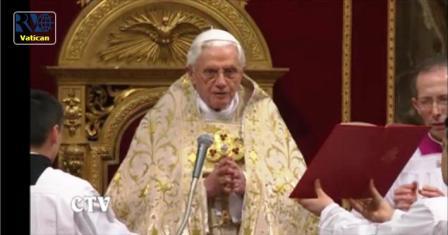



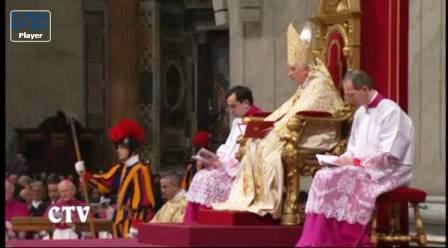

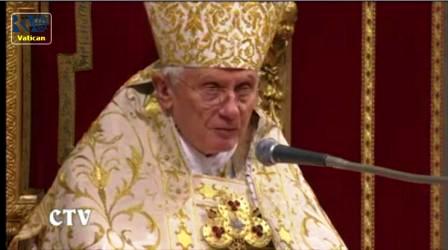
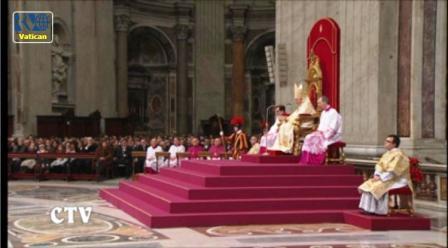


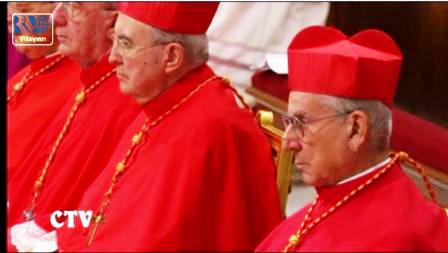


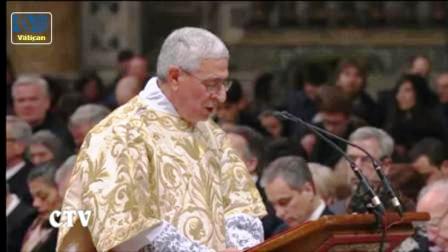
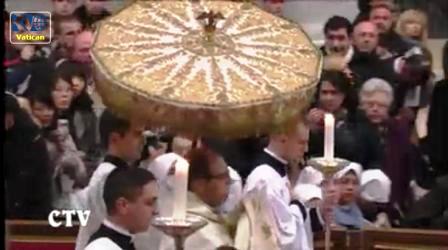
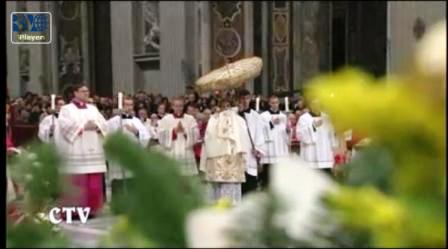
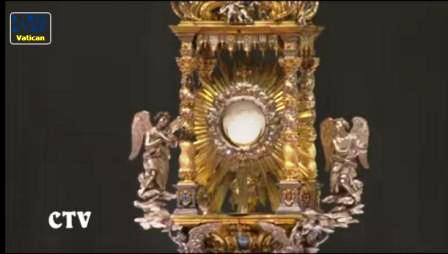
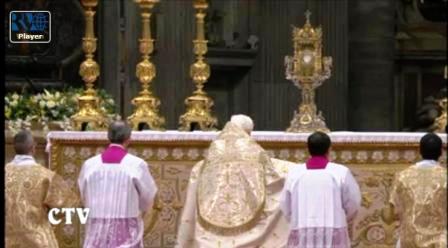


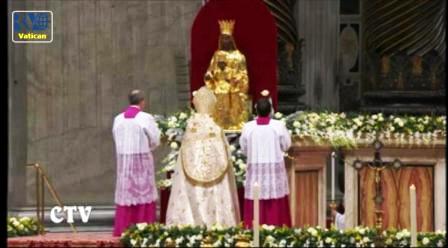
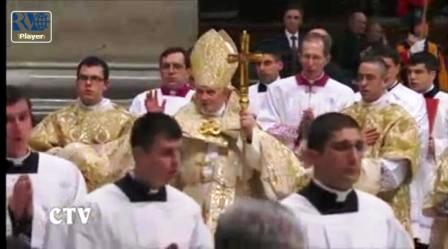
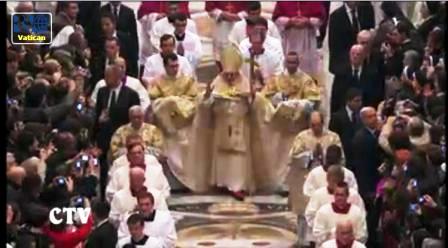
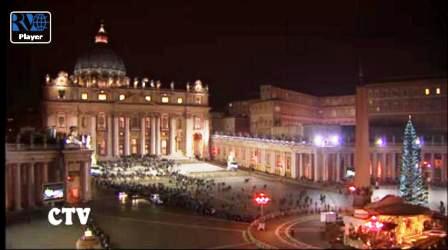
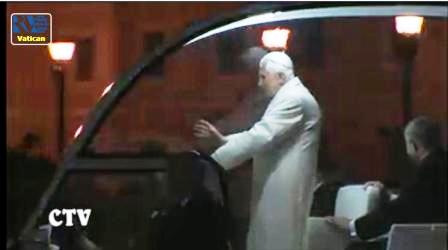
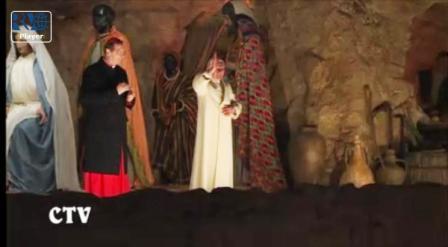




































Is the current position of the Papal Throne the traditional position in the Basilica or has it been moved from a previous place?
Dr. Eric,
If by “traditional position” you mean the position where the Throne was placed in pre-Vatican II times, before the Pauline reforms, then no, the Throne hasn’t reached that position yet.
The “traditional position”, in that sense, is the placement of the Throne at the front of the Altar of the Chair, facing the Altar of the Confession. An observer standing at the entrance of the basilica facing the aisle would see the Altar of the Confession across the nave and would see a glimpse of the papal Throne, that would be aligned with the aisle of the basilica.
In the times of John Paul II, a chair for the Pope, without dais, was placed in front of the Altar (upon the platform that covers part of the confessio), for all rites. That is also the position where the papal Throne currently is placed for Masses (being removed during the offertory and returing after Communion).
However, under Benedict XVI, for other liturgical actions that are not celebrated in the context of Mass, such as the Good Friday liturgy and the liturgy of the hours, a traditional Throne with dais has been restored to use, but it has not been placed in the traditional position. The exact placement of ithis Throne in non-Eucharistic liturgies celebrated by Benedict XVI has varied a bit.
Compare the photos of the good Friday liturgy, or of the vespers for the opening of the liturgical year, with today’s position: there is a slight change.
One final note: when the papal Throne was placed in front of the Cathedra Petri, the “choir side” was used by the members of the Papal Court: the bishops, archbishops and cardinals would sit there, their rows of pews or chairs facing the aisle of the choir side, so that a cardinal on the left side would face a cardinal on the right side just like an actual choir, and so the members of the Papal Court flanked the pope (this is still the position in use in St. John Lateran). This position, on the other hand, allowed more space for the people in the nave side of the Altar, as ambassadors, etc. and other members of the public would seat in a space that is now taken by prelates, and would thus sit closer to the Altar of the Confession.
Beautiful … just beautiful to contemplate.
I noticed lots of new singers in the Cappella Sistina, and lots of old singers gone. The music was fantastic as was the vesture.
Pro. Basto, I have been wondering about for awhile about the tidbit you mentioned about the platform where the throne sits for mass. The one that covers part of the confessio. When did this platform make its first appearance? I know there are recent pictures outside of papal ceremonies that show it M.I.A. Seems that since the election of B16, he has made sure that the platform and steps get covered in matching ornate carpeting. The platform obscures the reason the altar is placed there; that it is placed above relics of St Peter. The throne placement is a vast improvement as was seen at this vespers.
Teaguytom,
I’m not sure, but my understanding is that the platform made its first appearence still during the Council. For certain actions (I don’t know if liturgical or simply non-liturgical council sessions), Paul VI would sit there.